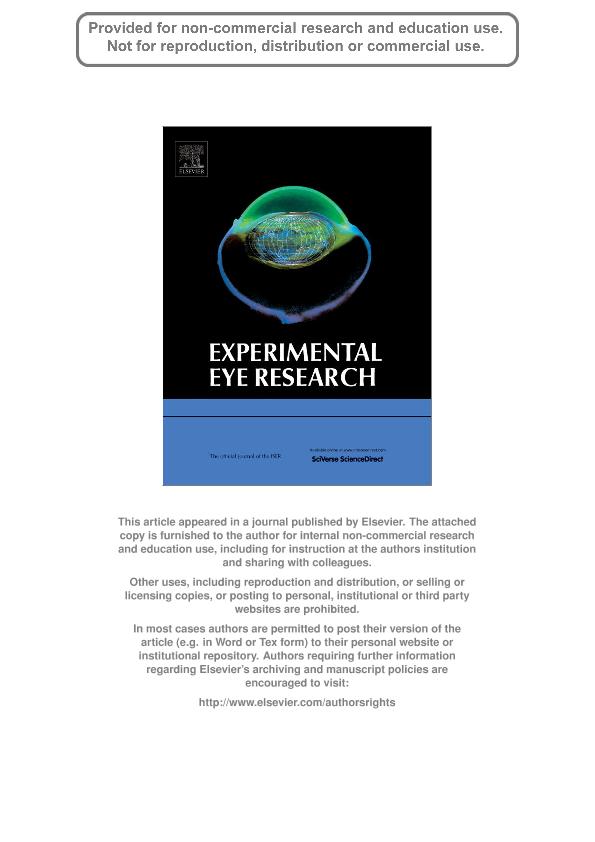Mostrar el registro sencillo del ítem
dc.contributor.author
Natalini, Paola Marisel

dc.contributor.author
Zulian, Sandra Edith
dc.contributor.author
Ilincheta, Monica Graciela

dc.contributor.author
Giusto, Norma Maria

dc.date.available
2016-02-29T19:12:33Z
dc.date.issued
2013-04
dc.identifier.citation
Natalini, Paola Marisel; Zulian, Sandra Edith; Ilincheta, Monica Graciela; Giusto, Norma Maria; Diacylglycerol kinase epsilon in bovine and rat photoreceptor cells. Light-dependent distribution in photoreceptor cells.; Academic Press Ltd-elsevier Science Ltd; Experimental Eye Research; 112; 4-2013; 139-150
dc.identifier.issn
0014-4835
dc.identifier.issn
http://www.ncbi.nlm.nih.gov/pubmed/23608524
dc.identifier.uri
http://hdl.handle.net/11336/4535
dc.description.abstract
The present study shows the selective light-dependent distribution of 1,2-diacylglycerol kinase epsilon (DAGK3) in photoreceptor cells from bovine and albino rat retina. Immunofluorescence microscopy in isolated rod outer segments from bleached bovine retinas (BBROS) revealed a higher DAGK3 signal than that found in rod outer segments from dark-adapted bovine retinas (BDROS). The light-dependent outer segment localization of DAGK3 was also observed by immunohistochemistry in retinas from albino rats. DAGK activity, measured in terms of phosphatidic acid formation from a) [3H]DAG and ATP in the presence of EGTA and R59022, a type I DAGK inhibitor, or b) [g-32P]ATP and 1-stearoyl, 2- arachidonoylglycerol (SAG), was found to be significantly higher in BBROS than in BDROS. Higher light-dependent DAGK activity (condition b) was also found when ROS were isolated from dark-adapted rat retinas exposed to light. Western blot analysis of isolated ROS proteins from bovine and rat retinas confirmed that illumination increases DAGK3 content in the outer segments of these two species. Light- dependent DAGK3 localization in the outer segment was not observed when U73122, a phospholipase C inhibitor, was present prior to the exposure of rat eyecups (in situ model) to light. Furthermore, no increased PA synthesis from [3H]DAG and ATP was observed in the presence of neomycin prior to the exposure of bovine eyecups to light. Interestingly, when BBROS were pre-phosphorylated with ATP in the presence of 1,2-dioctanoyl sn-glycerol (di-C8) or phorbol dibutyrate (PDBu) as PKC activation conditions, higher DAGK activity was observed than in dephosphorylated controls. Taken together, our findings suggest that the selective distribution of DAGK3 in photoreceptor cells is a light-dependent mechanism that promotes increased SAG removal and synthesis of 1-stearoyl, 2-arachidonoyl phosphatidic acid in the sensorial portion of this cell, thus demonstrating a novel mechanism of light-regulated DAGK activity in the photoreceptors of two vertebrate species.
dc.format
application/pdf
dc.language.iso
eng
dc.publisher
Academic Press Ltd-elsevier Science Ltd

dc.rights
info:eu-repo/semantics/openAccess
dc.rights.uri
https://creativecommons.org/licenses/by-nc-nd/2.5/ar/
dc.subject
Diacylglycerol Kinase Epsilon
dc.subject
Retina
dc.subject
Rod Outer Segment
dc.subject
Light
dc.subject
Vertebrate Photoreceptor Cells
dc.subject
Phophstidic Acid
dc.subject
Lipid Second Messenger
dc.subject.classification
Bioquímica y Biología Molecular

dc.subject.classification
Ciencias Biológicas

dc.subject.classification
CIENCIAS NATURALES Y EXACTAS

dc.title
Diacylglycerol kinase epsilon in bovine and rat photoreceptor cells. Light-dependent distribution in photoreceptor cells.
dc.type
info:eu-repo/semantics/article
dc.type
info:ar-repo/semantics/artículo
dc.type
info:eu-repo/semantics/publishedVersion
dc.date.updated
2016-03-30 10:35:44.97925-03
dc.journal.volume
112
dc.journal.pagination
139-150
dc.journal.pais
Estados Unidos

dc.journal.ciudad
Amsterdam
dc.description.fil
Fil: Natalini, Paola Marisel. Universidad Nacional del Sur. Departamento de Biología, Bioquímica y Farmacia; Argentina. Consejo Nacional de Investigaciones Científicas y Técnicas. Centro Científico Tecnológico CONICET Bahía Blanca. Instituto de Investigaciones Bioquímicas Bahía Blanca (i); Argentina
dc.description.fil
Fil: Zulian, Sandra Edith. Universidad Nacional del Sur; Argentina. Consejo Nacional de Investigaciones Científicas y Técnicas. Centro Científico Tecnológico CONICET Bahía Blanca. Instituto de Investigaciones Bioquímicas Bahía Blanca (i); Argentina
dc.description.fil
Fil: Ilincheta, Monica Graciela. Universidad Nacional del Sur. Departamento de Biología, Bioquímica y Farmacia; Argentina. Consejo Nacional de Investigaciones Científicas y Técnicas. Centro Científico Tecnológico CONICET Bahía Blanca. Instituto de Investigaciones Bioquímicas Bahía Blanca (i); Argentina
dc.description.fil
Fil: Giusto, Norma Maria. Universidad Nacional del Sur. Departamento de Biología, Bioquímica y Farmacia; Argentina. Consejo Nacional de Investigaciones Científicas y Técnicas. Centro Científico Tecnológico CONICET Bahía Blanca. Instituto de Investigaciones Bioquímicas Bahía Blanca (i); Argentina
dc.journal.title
Experimental Eye Research

dc.relation.alternativeid
info:eu-repo/semantics/altIdentifier/doi/10.1016/j.exer.2013.04.012
dc.relation.alternativeid
info:eu-repo/semantics/altIdentifier/doi/http://dx.doi.org/10.1016/j.exer.2013.04.012
dc.relation.alternativeid
info:eu-repo/semantics/altIdentifier/ark/http://www.ncbi.nlm.nih.gov/pubmed/23608524
Archivos asociados
